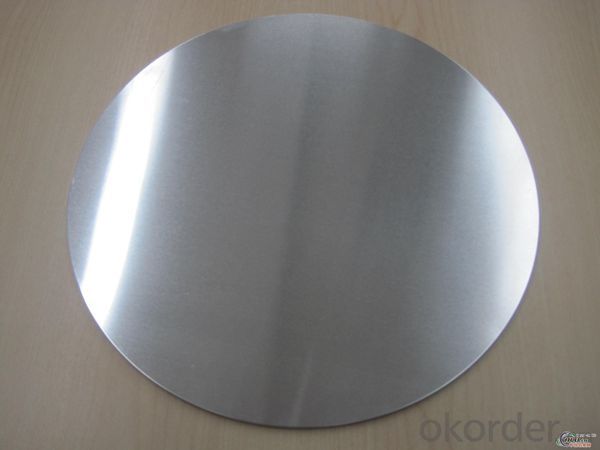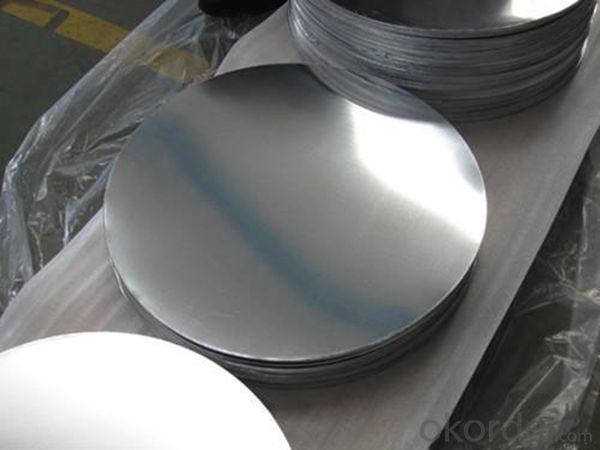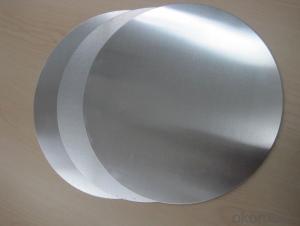Kitchen Useage Hot Rolling 1050 Aluminium Disc
- Loading Port:
- Tianjin
- Payment Terms:
- TT OR LC
- Min Order Qty:
- 5 m.t.
- Supply Capability:
- 600 m.t./month
OKorder Service Pledge
OKorder Financial Service
You Might Also Like
Item specifice
Kitchen Useage Hot Rolling 1050 Aluminium Disc
Professional aluminum product manufacturer
We have our own plant , Laboratory and engineer
Over 100 models can totaly satisfy your request
As powerful and stronger factory, our aluminum quality is very stable and reliable
2 years warranty period
Specifications:
Thickness:0.5mm-6.0mm
Width:100mm-900mm
Surface:Bright & smooth surface, not defects like white rust, oil patch.
Product Information :
Product | Aluminum Circle |
Alloy | 1050 1060 1070 1100 1200 |
Temper | O, H12, H14, H18 and H24... |
Thickness | 0.5mm-6.0mm |
Diameter | 100mm-900mm |
Lead Time | Within 30-45 days after receiving deposit |
Packing | Standard Exporting wooden pallets or based on customer requirement |
Material | Using high-tech machinery utilizing premium grade Aluminium Coil. Customized according to the needs and demands of the clients these can be availed at different technical specifications. |
Surface: | Bright & smooth surface, free from defects like white rust, oil patch, edge damage. |
Application | Aluminium Circles are used in Reflective Sign Boards, Road Furniture, Utensils, Sand witch Bottom, Cooker, Non-Stick etc. |


- Q:What are the different methods of bending aluminum sheets?
- There are several methods of bending aluminum sheets, each with its own advantages and limitations. Some of the commonly used methods include: 1. Press Brake Bending: This method involves clamping the aluminum sheet between a punch and a die on a press brake machine. The sheet is then bent by applying force through the punch, which pushes against the die. Press brake bending is ideal for high-volume production and can achieve precise and consistent bends. 2. Roll Bending: Also known as a three-roll bending process, this method uses a set of three rollers to gradually bend the aluminum sheet into the desired shape. Roll bending is suitable for creating cylindrical or conical shapes and is often used in industries like automotive and aerospace. 3. Stretch Bending: In this method, the aluminum sheet is clamped at both ends while a stretching force is applied in the middle. The sheet is elongated and bent simultaneously, resulting in a curved shape. Stretch bending is commonly used for producing curved profiles with a smooth and uniform finish. 4. Heat Bending: By applying heat to the aluminum sheet, it becomes more pliable and can be easily bent into desired shapes. Heat bending is often performed using a heat gun or an oven to soften the metal, followed by manual or mechanical bending. This method is useful for creating complex and intricate shapes. 5. Incremental Bending: This method involves bending the aluminum sheet in multiple steps or increments, gradually increasing the bend angle with each step. Incremental bending allows for greater control over the bending process and is commonly used for forming U-shaped or V-shaped bends. 6. Roll Forming: In roll forming, the aluminum sheet is fed through a series of rollers, each gradually bending the sheet a little more. This continuous process is ideal for producing long and consistent bends, often used in the production of aluminum profiles and extrusions. It is worth noting that the choice of bending method depends on factors like the desired bend angle, the thickness and grade of the aluminum sheet, the required precision, and the volume of production.
- Q:What are the different types of surface treatments for aluminum sheets in the marine industry?
- Aluminum sheets are extensively utilized in the marine industry due to their lightweight nature and resistance to corrosion. To enhance their durability and performance in marine environments, various surface treatments are employed. These treatments provide an added layer of protection against corrosion, oxidation, and other types of wear and tear. Several surface treatments are available for aluminum sheets in the marine industry. One common treatment is anodizing, which involves an electrochemical process that creates an oxide layer on the aluminum surface. This layer adds strength, improves corrosion resistance, and can be dyed for aesthetic purposes. Another method is powder coating, which enhances the appearance and durability of aluminum sheets. It involves applying a dry powder to the surface and heating it to create a protective coating. Powder coating offers excellent resistance against corrosion, UV rays, and scratches. Chromate conversion coating, also known as chemical film coating or chromating, is another surface treatment option. This process immerses the aluminum sheets in a solution containing chromate compounds, forming a thin layer of chromate conversion coating on the surface. This enhances corrosion resistance and provides a suitable base for subsequent painting or bonding. Paint coating is another surface treatment method in the marine industry. It not only enhances appearance but also protects against corrosion, saltwater, and harsh environmental conditions. Epoxy or polyurethane-based paints are commonly used for marine applications. Mechanical treatments, such as brushing, grinding, or polishing, can also be performed on aluminum sheets to improve their surface finish. These treatments remove impurities, smooth out imperfections, and enhance the overall appearance of the aluminum surface. Each surface treatment has its own advantages and is chosen based on the specific requirements of the marine application. By selecting the appropriate treatment, manufacturers can ensure that aluminum sheets meet the necessary performance and durability standards in the demanding marine industry.
- Q:What does 1060h/24 mean in aluminium alloy?
- Each digit in the 1060-H24 stands for the following meanings:First, a number of Arabia 1 is representative of pure aluminum (aluminum is aluminum content above 99% aluminum, in addition to the beginning and start with 2-8 are 2### for copper and aluminum magnesium alloy, 3### aluminum manganese alloy, 4### alloy, 5### alloy and so on)Two, second, Arabia number 0, said the original alloy, such as 1, said the original alloy after a modification, 2 means that the original alloy after two modificationsThree, third and four 60 two Arabia data represent the value behind pure aluminum content of 99% per cent in pure aluminum, said 60 pure aluminum aluminum content of 99.60%, as the standard 1050 indicates the aluminum content of pure aluminum, 99.50% of the 1070 said that the aluminum content of 99.70% pure aluminum alloy in the back. In two the number of Arabia aluminum has no special meaning, is only used to identify the different alloys in the same group, said its second modifications.Four, H24 H said the work hardening of the state, and some do not have H but T said it is heat treatment.24 machining process control hardness and other properties, in addition to 24 and 12, 14, 16, 18, 22, 26, 34, 36 and so on, usually at the end of 4 is a semi hard state.1060O, 1060-H22, 1060-H24, 1060-H18 state is arranged from soft to hard.
- Q:Can aluminum sheets be used for furniture manufacturing?
- Yes, aluminum sheets can be used for furniture manufacturing. Aluminum is a versatile material with several advantageous properties that make it suitable for furniture production. It is lightweight, durable, corrosion-resistant, and can be easily molded into various shapes and sizes. Additionally, aluminum has a sleek and modern aesthetic, making it a popular choice for contemporary furniture designs. Aluminum sheets can be used to create frames, legs, and other structural components for different types of furniture, including chairs, tables, shelves, and cabinets. The versatility and durability of aluminum make it a viable option for furniture manufacturing, especially for outdoor or industrial furniture that requires resistance to harsh weather conditions or heavy use.
- Q:How does the thickness of aluminum sheet affect its strength?
- The strength of an aluminum sheet is directly influenced by its thickness. Generally, a thicker aluminum sheet will possess greater strength compared to a thinner one. This correlation arises from the fact that the thickness of the sheet determines the quantity of material present, ultimately impacting its ability to endure external forces or loads. Typically, the strength of a material is measured based on its capacity to withstand stress without deforming or failing. Thicker aluminum sheets have a larger volume of material, resulting in an increased number of atoms and bonds to counteract forces. Consequently, these sheets exhibit a heightened resistance to deformation or failure, thus rendering them stronger. Furthermore, thicker aluminum sheets boast a higher load-bearing capacity. Consequently, they can endure heavier loads or higher pressures without distorting or failing. The augmented thickness allows for a greater distribution of the load, thereby reducing the stress placed on individual atoms and bonds within the sheet. Nevertheless, it is crucial to acknowledge that there exists a limit to the thickness at which the strength of an aluminum sheet reaches a plateau. Once this threshold is surpassed, further increasing the thickness may not yield significant improvements in strength. This limitation arises from the influence of other material properties of aluminum, such as its crystal structure and grain boundaries, which also contribute to determining its strength. To conclude, the strength of an aluminum sheet is directly linked to its thickness. Thicker sheets possess more material, enabling them to effectively resist deformation or failure under stress. Furthermore, their increased thickness allows them to support heavier loads or endure higher pressures. However, it is important to recognize that there is a limit to the thickness at which the strength plateaus, as other material properties also come into play.
- Q:How many square meters does the aluminum plate engrave?
- The price of aluminum sheet is calculated according to the price of aluminum ingot + processing fee (aluminum plate state), and the specific price is also different according to the size and size of aluminum sheet. If you have any questions, please ask, thank you.
- Q:Can aluminum sheets be used for packaging?
- Aluminum sheets have the ability to be utilized for packaging purposes. The packaging industry highly values aluminum due to its numerous advantageous properties, as it is a versatile and extensively used material. The lightweight nature, strength, durability, and resistance to corrosion of aluminum make it an optimal choice for packaging applications. By using aluminum sheets, it is effortless to mold them into various shapes and sizes, offering the advantage of design flexibility and customization. In addition, aluminum possesses impermeability to light, moisture, gases, and microorganisms, guaranteeing the safety and preservation of the packaged goods. Its exceptional heat conductivity also allows for efficient heat transfer during processes like sterilization or pasteurization. Moreover, aluminum is environmentally friendly as it can be recycled, making it a sustainable option for packaging. All in all, aluminum sheets are a remarkable choice for packaging purposes due to their exceptional properties and versatility.
- Q:Can aluminum sheets be used for signage?
- Yes, aluminum sheets can be used for signage. Aluminum is a versatile and durable material that is commonly used in the sign-making industry. It is known for its lightweight yet sturdy properties, making it ideal for outdoor and indoor signage. Aluminum sheets are resistant to corrosion, rust, and fading, ensuring that the signage will last for a long time. Additionally, aluminum can be easily cut and shaped into various sizes and designs, allowing for creative and customized signage solutions. The material also provides a smooth surface that can be painted, printed, or laminated with graphics and text, making it highly versatile for different signage applications. Overall, aluminum sheets are a popular choice for signage due to their durability, versatility, and aesthetic appeal.
- Q:How do you bend aluminum sheets?
- To bend aluminum sheets, you can use a variety of methods such as using a bending machine, a brake press, or even hand tools like a mallet and a block of wood. The process typically involves clamping the sheet securely, applying gradual pressure to the desired bending point, and manipulating the metal until the desired angle is achieved. It is important to take into consideration the thickness of the sheet and use appropriate techniques to avoid damaging or cracking the aluminum.
- Q:Are aluminum sheets suitable for roofing systems?
- Indeed, aluminum sheets prove to be an appropriate option for roofing systems. The durability, lightweight composition, and corrosion resistance of aluminum render it a favored choice for rooftops. Moreover, aluminum possesses fire-resistant properties and can endure harsh weather conditions, including strong gusts and heavy precipitation. With their long lifespan and minimal upkeep requirements, aluminum roofing sheets present a financially sound choice over time. Furthermore, the highly reflective nature of aluminum aids in reducing energy expenses by maintaining cooler indoor temperatures in hot climates. In summary, aluminum sheets emerge as a dependable and effective preference for roofing systems.
1. Manufacturer Overview |
|
|---|---|
| Location | |
| Year Established | |
| Annual Output Value | |
| Main Markets | |
| Company Certifications | |
2. Manufacturer Certificates |
|
|---|---|
| a) Certification Name | |
| Range | |
| Reference | |
| Validity Period | |
3. Manufacturer Capability |
|
|---|---|
| a)Trade Capacity | |
| Nearest Port | |
| Export Percentage | |
| No.of Employees in Trade Department | |
| Language Spoken: | |
| b)Factory Information | |
| Factory Size: | |
| No. of Production Lines | |
| Contract Manufacturing | |
| Product Price Range | |
Send your message to us
Kitchen Useage Hot Rolling 1050 Aluminium Disc
- Loading Port:
- Tianjin
- Payment Terms:
- TT OR LC
- Min Order Qty:
- 5 m.t.
- Supply Capability:
- 600 m.t./month
OKorder Service Pledge
OKorder Financial Service
Similar products
New products
Hot products
Related keywords





























